Global Monitor (July 2007)
Pistachio plant gives new meaning to green
Now you can feel really green about those tasty green pistachio snacks. Paramount Farms in California’s agriculture-rich Central Valley, billing itself as the "world’s largest vertically-integrated supplier of pistachios and almonds," has commissioned a 1.1-MW, eight-acre, $7.5 million solar photovoltaic (PV) electric generating plant. SolarCraft of Novato, Calif., installed the solar panels.
The plant (Figure 1), according to a SolarCraft news release, "is one of the largest single-site, privately-owned, operating solar plants in the U.S." Paramount Farms says it expects to get about 15% of its electricity from the solar arrays.
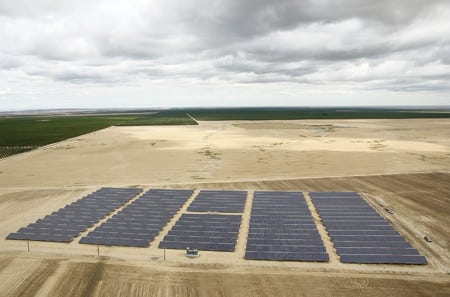
1. Green nuts. Paramount Farms, the world’s largest pistachio and almond producer, is powering its California operations with 1.1 MW of photovoltaic-produced power. Courtesy: SolarCraft
Dave Szeflin, Paramount Farms vice president for operations, said the agribusiness company "is committed to a balanced green strategy, one that utilizes clean energy to reduce costs and improve efficiency." Paramount Farms has 30,000 acres of pistachio orchards, the largest planting in the Western Hemisphere, and more than 40,000 acres of almond orchards. The company’s products are sold to consumers under the Sunkist and Everybody’s Nuts brands as well as under private label and bulk sales.
The plant uses Uni-Solar (www.uni-solar.com) amorphous thin-film PV panels. According to SolarCraft, "The system will pay for itself in approximately six years." Chris Bunas, SolarCraft VP, said, "With 25-year warranties and 40+ year design life on the major system components, this system will be positively affecting Paramount’s bottom line for many years to come."
SolarCraft has been providing solar thermal and electric consulting, design, sales, and installation and maintenance for over 23 years, the company said.
Slightly sun-powered grill
Also on the PV front, Ted’s Montana Grill in Tallahassee, Fla., has installed 66 PV panels on the restaurant, which will supply 5% of the restaurant’s energy needs. The restaurant is a joint venture of media entrepreneur and environmental activist Ted Turner and investor George McKerrow. In a press release, McKerrow said, "Tallahassee was an ideal location because both the city and the state have strong incentives for businesses that use alternative energy sources and because we own the property and the building there."
Add that Florida is named, correctly, the Sunshine State.
The grill—which features Turner’s Montana-raised buffalo in its burgers, pot roast, meatloaf, and steaks—is equipped with net metering capability, to take advantage of Florida’s net metering program.
The Ted’s Montana Grill chain, based in Atlanta, has 49 restaurants in 18 states. The chain goes green to the gills: Menus are printed on recycled paper, paper straws replace plastic ones, and "to-go" cups are made of corn starch. Soft drinks come in recyclable glass bottles (most plastic soft-drink bottles these days are also recyclable), and many of the restaurants employ low-flow toilets. All the restaurants are nonsmoking.
Will lithium revolutionize hydrogen storage?
A team of British researchers have developed a lithium compound they say may make it practical to store enough hydrogen in a fuel cell car to enable it to cover more than 300 miles before refueling. Among other problems with fuel cell vehicles is their current inability to store enough fuel to match gasoline-powered vehicles.
The team includes researchers from the University of Birmingham, Oxford University, and the Rutherford Appleton Laboratory in Oxfordshire. They have tested thousands of solid-state compounds in search of a light, cheap, readily available storage material for H2 and have settled on a lithium-based compound. It involves what they claim is a "well-established process called ‘chemisorption,’ in which atoms of a gas are taken into the crystal structure of a solid-state chemical and released when needed" (Figure 2).
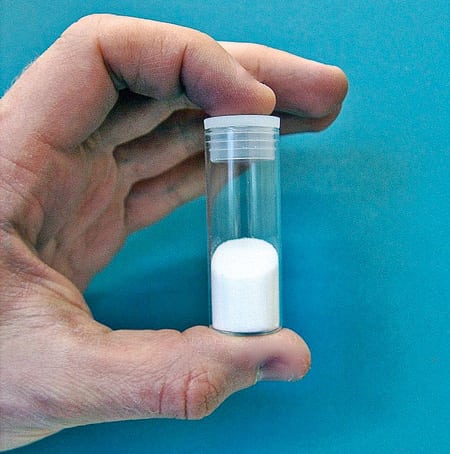
2. Solid-state storage. British scientists have developed a lithium storage technology for elemental hydrogen. Hydrogen storage has been a major barrier to widespread use of nature’s original energy carrier. Courtesy: UK-SHEC
The research team, supported by the UK Sustainable Hydrogen Energy Consortium (UK-SHEC, www.uk-shec.org) and funded by the government, has come up with what it says, in a news release, is "a variety of lithium hydride . . . that could offer the right blend of properties." Oxford’s Peter Edwards, UK-SHEC coordinator, said, "This could be a major step toward the breakthrough that the fuel cell industry and the transport sector have waited for. This work could make a key contribution to helping fuel cell cars become viable for mass-manufacturing within around 10 years."
Today’s prototype and demonstration vehicles, notes the consortium, have a range of about 200 miles (well over the range of electric battery-powered vehicles). But to make a dent in the market, they need to achieve a range of 300 miles, which is impractical for current hydrogen storage technology. The news release notes that to achieve that range, "an on-board space the size of a double-decker bus would be needed to store hydrogen at standard temperature and pressure, while storing it as a compressed gas in cylinders or as a liquid in storage tanks would not be practical due to the weight and size implications."
In short, without a breakthrough in hydrogen storage, the notion of powering vehicles with the explosive and ubiquitous element is impractical.
The UK hydrogen consortium is supported by the Engineering and Physical Sciences Research Council (EPSRC, www.epsrc.ac.uk), the UK’s main agency for funding research and development in engineering and physical sciences. It invests about $1.5 billion annually in research and postgraduate training.
Calpine’s major Geysers geothermal upgrade
Calpine Corp. has launched a major, 80-MW expansion of its geothermal operations in California’s Geysers project, located in the heart of northern California wine country. According to Calpine (www.calpine.com), the five-year renovation will cost $75 million in its first year and will total around $200 million. The decision to make the investment, said Calpine, was driven by California’s requirement that investor-owned utilities in the state get 20% of their electricity from renewables by 2010. Recently, Southern California Edison signed a 10-year contract with Calpine for 225 MW from the Geysers. Calpine also has a new contract with Pacific Gas ‘ Electric.
Calpine CEO Robert P. May said, "Calpine was founded on geothermal production and remains committed to providing clean, reliable and affordable low-carbon and renewable power generation from our operations here in California and across the country."
Calpine’s program includes a new, two-year, multirig drilling program (Figure 3) to expand steam production and find new steam sources. The company will also rebuild eight older geothermal turbines to improve their efficiency, Calpine said. Doing so will upgrade the station by another 147 MW.
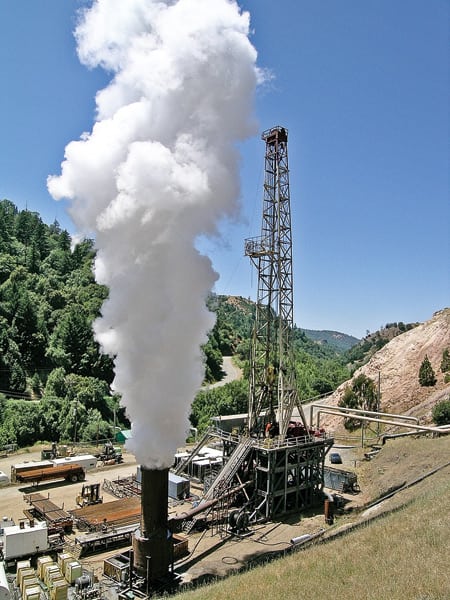
3. Geysers gushing. Calpine Corp. is making a major investment in upgrades at the Northern California geothermal Geysers generating site. This includes using drilling rigs, shown here, to drill for new thermal resources. Courtesy: Calpine Corp.
Located about 70 miles north of San Francisco, Geysers is the single-largest geothermal operation in the world, with Calpine’s 19 units generating 725 MW of renewable energy. The steam field covers 40 square miles in the Mayacamas Mountains. The field has 21 power plants, 350 steam wells, and 58 injection wells that replenish some of the steam wells with wastewater. The first commercial steam well at the Geysers went into service in 1954. Unlike wind and solar, geothermal is dispatchable.
California environmentalists are giving kudos to Calpine. Bernadette Del Chiaro of Environment California told the Los Angeles Times, "Geothermal is a terrific, clean, renewable resource that should be expanded. It’s a no-brainer to tap into the immense energy that we have just under the earth. And it’s 24-7, it’s not intermittent.
�
Rhone-Alps is French PV hot spot
The Rhone-Alps region, noted for Mt. Blanc and the exquisite green liquor Chartreuse, has emerged as the leading French region for solar energy research, production, and applications, according to the French Technology Press Office.
Thanks to changes in the government-mandated price for solar-generated power in France, photovoltaic energy is booming (Figure 4). The increase in payments for PV power has been coupled with a regional subsidy for power from Rhone-Alps. The government, which owns the electric business in France, declared the region the "solar competitiveness cluster in France," or "Tenerrids"—a triangle of the cities Chambéry, Grenoble, and Lyon. That gives the region access to various tax breaks, research and development funding, and other incentives. As a result, electricity prices for solar energy in France far exceed market prices, which themselves are government-subsidized.
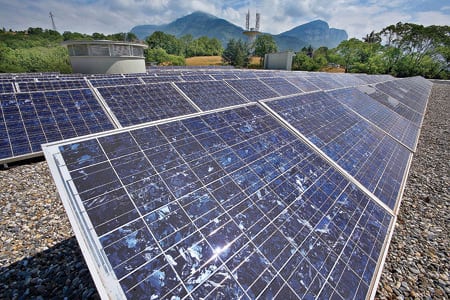
4. Hot spot. This array is part of a 1-MW PV installation on top of a water tank in Chambéry, France. Courtesy: French Technology Press Office
France’s National Solar Energy Institute (INES) is located near Chambéry in the French Alps (Figure 5). The institute hosts several R’D facilities whose staff work on issues such as thin films and solar-grade silicon production. The institute has a midterm goal of a "multicrystalline silicon cell with 20% conversion efficiency." Today’s PV cells are at about 15% efficiency, the press office said.
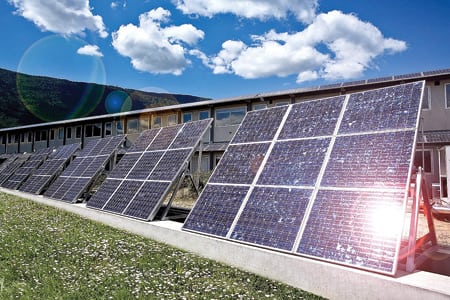
5. On-site PV. This array sits in front of the INES offices near Chambéry in the Rhone-Alps region of France, which has emerged at the nation’s leading solar energy area. Courtesy: French Technology Press Office
The region also has a test facility, operating since 2005, that has all the equipment needed for fabricating crystalline silicon cells. It is funded by the French Atomic Energy Commission. The test site is working to reduce the amount of silicon used in thin-film, multicrystalline silicon cells. This test facility is scheduled to move to INES by the end of the year.
Among the players in the PV market in the region is Tenesol, a subsidiary of Total and Electricité de France, the state-owned oil and electricity companies. Tenesol, based in the Lyon suburb of La Tour de Salvagny, opened a production plant last September with the capacity to produce 2.3 million square feet of PV modules, or enough to produce some 30 MW of electricity.
The regional economic development agency, ERAI, which has an office in Atlanta, Ga., is actively hunting for U.S. investment in the region’s PV industry. Its press office says, "For companies wanting to invest in the region’s PV industry, ERAI provides guidance and support free of charge, from the first area visit to site selection."
Fuel cell–powered ice-resurfacing machine
A hydrogen-powered ice resurfacer—a fuel cell–powered equivalent of Frank Zamboni’s eponymous machine, the Zamboni—has been touring ice rinks in the U.S. and Canada of late to demonstrate that hydrogen fuel cells, according to a U.S. Department of Energy news release, are ready to "smooth the way toward a future hydrogen economy by opening up a niche market."
The eP-ICEBEAR (Figure 6) was developed by the University of North Dakota’s Energy ‘ Environmental Research Center (www.undeerc.org) with funding from the DOE’s National Energy Technology Laboratory in the southern Pittsburgh, Pa., suburbs.

6. Environmentally friendly ICEBEAR. This DOE-funded machine runs on a hydrogen-powered fuel cell engine to resurface the ice on rinks used by hockey players and other skaters. Will it supplant the traditional Zamboni? Courtesy: National Energy Technology Laboratory
According to the DOE, "The crowded, enclosed space of an ice arena made the perfect venue for the introduction of hydrogen-powered vehicles. While on exhibition, the eP-ICEBEAR has proved much quieter and safer than the usual propane-powered resurfacers, which have sometimes caused dangerous carbon monoxide buildups on the ice while resurfacing." The only emission from the ICEBEAR, when running on hydrogen, is dihydrogen monoxide, also known as water.
Fuel cells run on hydrogen, but they can get the H2 from sources other than pure hydrogen. They can, with conversion technology, run on coal-derived synthesis gas, natural gas, gasoline, diesel, alcohol, and syngases from biomass or industrial wastes. In all cases, the results are motive power without significant emissions.
But so far, fuel cell technologies have not been even close to economically competitive with existing fossil fuel technologies. The DOE says it hopes the ice resurfacer could represent a tiny market in which fuel cell devices could compete for market share.
Frank Zamboni (1901–1988), owner of a large Southern California ice rink, invented the modern ice resurfacer in 1949. His machine made the task of smoothing ice after skaters had turned its surface into a crazy quilt of grooves and pits much faster and more efficient. The story of the Zamboni is available at the company’s web site (www.zamboni.com/welcome.html).
Westinghouse proposes revised AP100 design
Responding to its potential customers, Westinghouse Electric Corp. (www.westinghouse.com) has formally asked the U.S. Nuclear Regulatory Commission (NRC) to revise its application for design certification for its AP1000 advanced reactor, which won NRC approval in 2005.
Westinghouse said its proposed "revision 16" for the 1,000-MW pressurized water reactor, "will aid in reducing the cost, schedule and risks for U.S. utilities that plan to apply for combined construction and operating license (COL) applications with the NRC later this year. Additionally, the revision will contribute to increased standardization of the AP1000, making the NRC’s review of AP1000 combined COL applications more efficient."
The proposed license revision, said Westinghouse, also includes enhanced "security and aircraft crash resistance." Westinghouse spokesman Scott Shaw said the company made the concrete structure around the reactor (Figure 7) more robust, but he would not reveal further details. Shaw said other changes focused on instrumentation and the plant’s control room.
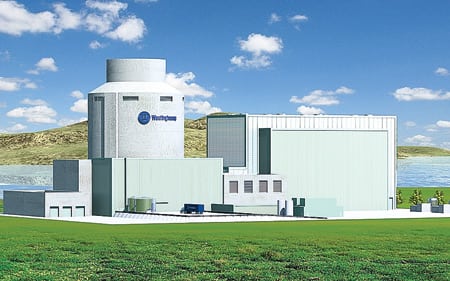
7. AP1000 makeover. Westinghouse proposes some customer-driven changes to the AP1000 design, shown here in an artist’s rendering, to increase its ability to withstand aircraft crashes and shorten licensing periods. Courtesy: Westinghouse Electric Corp.
Ed Cummins, Westinghouse’s regulatory chief, said, "The revision includes design changes to the AP1000 requested by our customers and developed by Westinghouse as part of design finalization. We’re happy to be working with our customers through NuStart to bring the AP1000 to design finalization and, ultimately, closer to new nuclear build."
The NuStart coalition, based in Kennett Square, Pa., outside of Philadelphia, gave kudos to the Westinghouse filing. Marilyn Kray, NuStart president, said, "When you combine the design expertise of the vendor with the collective operating experience of the NuStart members, the result is a plant design that is not only standard, but reflects the lessons learned by the industry."
NuStart, which has cost-sharing money from the DOE to develop its license applications, consists of nine U.S. nuclear utilities, Electricité de France, and reactor vendors Westinghouse and General Electric. NuStart announced in September 2005 that it had selected the Tennessee Valley Authority’s Bellefonte site for a COL for an AP1000 unit. NuStart selected Entergy’s Grand Gulf site for a COL for a GE "economic simplified boiling water reactor," or ESBWR.
Sandia perfects solar alignment
A Sandia National Laboratories researcher in New Mexico has come up with a device that could make parabolic trough solar energy collector systems more efficient and affordable. Rich Diver, working with fellow researcher Tim Moss, has proposed a new "theoretical overlay photographic" (TOP) technology that is garnering interest from the solar industry because of its utility and simplicity.
Says Diver, "TOP alignment could cure a significant problem with trough systems—inaccurate mirror alignment that prevents sunlight from precisely focusing on solar receivers. Improperly-aligned mirrors result in lost and wasted energy."
Solar thermal parabolic troughs use curved mirrored surfaces to focus sunlight on a tube running the length of the trough (Figure 8). The mirror focuses sunlight on the tube, which contains oil that is heated to high temperatures. The oil is then routed to steam generators, where it boils water to create steam that turns steam-turbine generators.
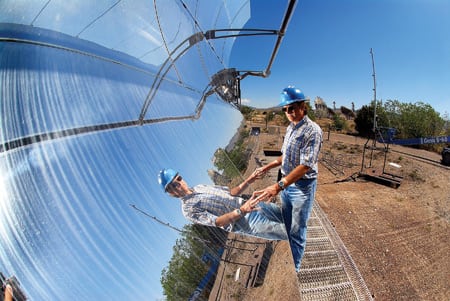
The world’s largest parabolic trough array is in the Mojave Desert near Barstow, Calif. It includes the ill-fated Luz project. Nine plants can produce 354 MW of peak power at the facility. A 64-MW plant is planned to supply power to Las Vegas, and a 1-MW plant is located in Arizona.
But lack of accurate mirror alignment reduces the efficiency of these plants, says Diver. So he came up with an optical approach to rapidly and effectively diagnose the alignment of the parabolic receivers and provide correct alignment coordinates. TOP consists of a pole with five cameras along it, says Albuquerque-based Sandia in a press release. Four cameras take digital images of the four mirrors on the parabolic frame. The middle camera looks at the module’s center point, where there is a boresight gauge.
Computers then use vector algebra and projection theory from the boresight camera to predict the path of perfectly aligned mirrors. That’s overlaid on the images of the actual mirrors, with the comparison guiding the instructions for correct alignment. "This whole process is very simple," says Diver. "Once the mirrors are aligned, the energy savings start. It’s like picking money off the ground. And the mirrors are aligned for the life of the plant."
Diver and Moss have tested the technology at a Sandia facility and at a trough installation near Tucson, Ariz. The next step, they say, is a test at Kramer Junction in the Mohave near Barstow.
SCE wants comprehensive coal study
Southern California Edison (SCE) has asked for state approval of a feasibility study that would examine combining advanced clean coal technologies in a full-scale, 600-MW commercial power plant. The utility, an Edison International subsidiary, notes that all of the elements it wants to put together "are being considered or tested in clean coal projects elsewhere." According to SCE, there are some 25 to 30 projects in "some stage of study or development."
But the Edison plan would be the first to see how it might be possible to put them together to create what the company is calling "clean hydrogen power generation" (CHPG). "Edison believes that if California and the nation are to significantly reduce greenhouse gas emissions and other pollutants while increasing power supplies using domestic fuels, companies like ours must take the lead exploring the feasibility of these advanced technologies," said Edison International CEO John Bryson.
The CHPG proposal would look at a process that starts with gasifying coal and then turning the synthesis gas CO and hydrogen into a stream of hydrogen by stripping out the hydrogen and using a shift conversion to convert the CO to additional hydrogen and CO2 (Figure 9).
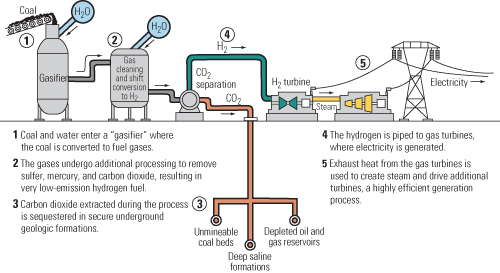
9. Coal process flow. Southern California Edison wants to make a thorough, ground-up examination of advanced coal-fired electric generation technologies, despite the fact that the state has banned coal-fired power. The Los Angeles utility wants its customers to pay for the study. Source: Southern California Edison Co.
The carbon dioxide extracted during the gasification process would be sequestered in underground geologic formations in the SCE plan. The hydrogen would be piped to combustion turbines to generate electricity. Waste heat would be used to make steam to run through steam-turbine generators.
Edison wants approval from the California Public Utilities Commission to spend $52 million collected in rates over two years to run the study. Said Bryson, "This proposal is part of a larger strategy we advocate for reducing U.S. greenhouse gas emissions—increased purchases of renewable energy, increased support for energy efficiency, switching to cleaner transportation fuels, and investment in emerging clean coal generation technologies."
Edison was the sponsor of the first major project to gasify coal for power generation, the 110-MW Cool Water demonstration project near Barstow, Calif., in the mid-1980s. The DOE said that Cool Water "established the early technical foundation for future integrated gasification combined cycle power plants."
Ironically, should the project show that the technology combination is feasible, Edison might have to get state law changed in order to employ it. Current California law forbids use of coal in electric generation in the state and forbids utilities to import new coal-fired electricity from out of state.
POWER digest
News items of interest to power industry professionals.
Alstom lines up major UK CHP project. Alstom has signed a contract worth about $774 million for construction of a 1,275-MW turnkey combined heat and power (CHP) plant on the Isle of Grain in the UK county of Kent. It would be the largest CHP plant in the UK. The contract with E.ON also includes a 12-year service agreement.
Alstom says this award, part of a plan to upgrade and replace power stations in the UK, is the first engineering, procurement, and construction contract the company has won with E.ON for its GT26 gas turbine–based, combined-cycle technology. Alstom says the plant is made up of three combined-cycle units, each including one gas turbine, one steam turbine, and one high-efficiency turbogenerator. A liquefied natural gas regasification terminal, near the plant, will use the waste heat.
In other Alstom news, the French-owned company said it has won a gas turbine upgrade contract from the Korea South East Power Co. to refurbish six GT11N units to GT11M technology. The deal includes new turbine blades and vanes, heat shield segments, vane carrier, and exhaust gas housing. The result, said Alstom, is an increase of about 12% in power output at unchanged firing temperatures.
Siemens lays out the FACTS at SCE. Siemens has installed the largest static volt ampere reactive compensation (SVC) system in North America for Southern California Edison, strengthening a transmission path from Arizona to California. Siemens said it got its SVC technology in place after only 13 months.
Siemens USA said SCE awarded it the contract in early August 2005 on a complete turnkey basis. The initial order for the line was for a 525-kV, 60-Hz, –110/+440 MVAR system at the Devers substation outside Palm Springs, Calif. After the contract was signed, said Siemens, Edison asked to shorten the delivery time by 11 months, which Siemens said it was able to accomplish with the cooperation of its subcontractors and with Edison.
According to Siemens, Edison used manually controlled mechanically switched capacitors and reactors to control fluctuations of voltage above and below the 500-kV level. The new flexible alternating current transmission systems (FACTS) technology, said Siemens, does this automatically, without input from Edison control operators, using light-fired thyristors as high-speed switching devices. This, says Siemens, results in a "substantial increase in reliability."
FACTS devices are used for the dynamic control of voltage, impedance, and phase angle of high-voltage AC lines. They also provide strategic benefits for improved transmission system management through better utilization of existing transmission assets; increased transmission system reliability and availability; increased dynamic and transient grid stability; and enabling environmental benefits.
First private plant in Bahrain. Siemens Power Generation has also completed a 950-MW combined-cycle, gas-fired plant in the Kingdom of Bahrain, making it the first independent, private-sector generation plant in the kingdom. Al Ezzel Power Co. ordered the plant from Siemens.
Al Ezzel shareholders include Suez Entergy International, the Gulf Investment Corp., and the Pension Fund Commission of the government of Bahrain. The engineering, procurement, and construction contract was awarded in November 2004 and completed on time in May 2007. It consists of four SGT5-2000E gas turbines and two steam-turbine gensets.
Basin Electric building 2nd Groton gas-fired unit. Basin Electric Power Cooperative, based in Bismarck, N.D., has begun construction on a second 95-MW gas-fired unit at the Groton station near Groton, N.D. The public power generation and transmission utility (one of the largest in the U.S.) received a "finding of no significant impact," known in the trade as a "FONSI," in late April in a final federal environmental impact statement (EIS), clearing the way for construction.
The EIS, written by the U.S. Department of Agriculture’s Rural Utilities Service, concluded that the second unit at the Groton site won’t impact air, water, noise, wetlands, or other interests. According to Dick Shaffer, Basin Electric’s project coordinator, the second unit at the station will essentially duplicate the first, a GE Energy 95-MW LMS100 gas turbine.
According to Basin, the first unit was the first and only commercial application of the GE turbine, and Unit 2 will be the second. According to a Basin Electric press release, the "major difference from Unit 1 is that Unit 2 will not have a synchronous clutch. The LMS100 is a simple-cycle gas turbine designed by GE Energy, which uses a combination of frame and aeroderivative technology."
Basin says it hopes to have the second unit available in June 2008. Basin generates and transmits electricity to 121 member rural electric systems in Colorado, Iowa, Minnesota, Montana, Nebraska, New Mexico, North Dakota, South Dakota, and Wyoming. The distribution utilities, in turn, have about 2.5 million customers.